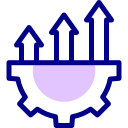Optimizing Workflows with Digital Productivity Tools
Digital productivity tools have revolutionized the way organizations and individuals manage their daily tasks, projects, and overall workflows. By integrating the right mix of digital solutions, businesses can significantly enhance efficiency, reduce repetitive manual work, and foster better collaboration across teams. This guide explores the strategies and benefits of leveraging digital productivity tools to streamline your workflows and achieve optimal outcomes.

Enhancing Collaboration and Communication
01
Real-Time Messaging Platforms
Real-time messaging platforms have transformed workplace interactions by making communication instantaneous and accessible. These tools allow teams to exchange information quickly, clarify doubts, and make decisions collaboratively without the delays associated with traditional email correspondence. The ability to organize conversations around specific projects, departments, or topics also improves clarity and keeps discussions focused. As companies transition to hybrid or remote models, real-time messaging ensures that team cohesion and mutual understanding are maintained, minimizing miscommunication and speeding up decision-making processes.
02
Project-Based Collaboration Hubs
Project-based collaboration hubs centralize all relevant files, discussions, and tasks in one easily accessible location. Such platforms help teams coordinate work more effectively by providing a transparent overview of project status, responsibilities, and upcoming deadlines. This centralization not only reduces the risk of losing critical information but also elevates project accountability and transparency. Members can quickly locate necessary documents, track progress, and communicate updates, improving workflow coherence and allowing teams to react proactively to changes or challenges.
03
Video Conferencing Solutions
Video conferencing solutions play a critical role in fostering connectivity among distributed or remote teams. Face-to-face meetings, even in virtual settings, facilitate clearer communication, build trust, and promote a sense of camaraderie. Advanced features, such as screen sharing, virtual whiteboards, and breakout rooms, turn virtual meetings into interactive collaborative sessions. As organizations continue to embrace remote work, video conferencing ensures that teams can collaborate efficiently, discuss complex topics in-depth, and maintain the human connection necessary for effective teamwork and morale.

Workflow Automation Platforms
Workflow automation platforms enable businesses to map out their daily processes and implement automated actions that trigger based on defined conditions. By automating everything from data entry to approval chains, organizations eliminate bottlenecks and human error, ensuring consistent task execution. These platforms can integrate with a variety of business applications, providing seamless transfer of information and reducing manual intervention. As a result, employees experience fewer disruptions and have more time to contribute creatively and strategically to the company’s goals.

Task Scheduling Tools
Task scheduling tools improve time management by automatically assigning, tracking, and reminding team members about their responsibilities. By embedding these tools into the workflow, organizations can visually organize workloads, set recurring tasks, and ensure no deadlines are missed. Automated notifications and integrations with calendars or project management systems help keep everyone aligned and aware of shifting priorities. This structure supports productivity by reducing uncertainty, promoting accountability, and ensuring that team progress remains on course without constant manual oversight.

Document Management Automation
Managing documents efficiently is essential for any organization, and automation tools streamline the entire process from creation to storage and retrieval. Such tools can automatically organize files, track different versions, and ensure the right people have access to the most up-to-date documents. Automating permissions, archiving, and version control reduces the likelihood of errors or unauthorized access. By delegating these administrative tasks to digital platforms, employees spend less time searching for information and more time applying that information in their work.
Streamlining Task and Project Management
Digital Kanban Boards
Digital Kanban boards offer a visual approach to managing tasks and workflows, providing clear insights into the status of individual items and the overall project. Users can easily move tasks across different stages, highlight bottlenecks, and assign responsibilities. The visual nature of Kanban boards enhances understanding, promotes accountability, and fosters a culture of continuous improvement. Real-time updates make it possible for teams to adapt quickly to changes, optimize resource allocation, and maintain momentum as priorities evolve.


Integrated Project Dashboards
Integrated project dashboards consolidate data from various sources, offering a holistic view of project performance, resource utilization, and timelines. These dashboards help managers and team members identify trends, anticipate potential delays, and make informed decisions based on up-to-date information. With interactive charts, progress indicators, and customizable layouts, dashboards transform complex data into actionable insights. By making project metrics visible and accessible, organizations encourage transparency and foster a results-oriented culture.
Join our mailing list
